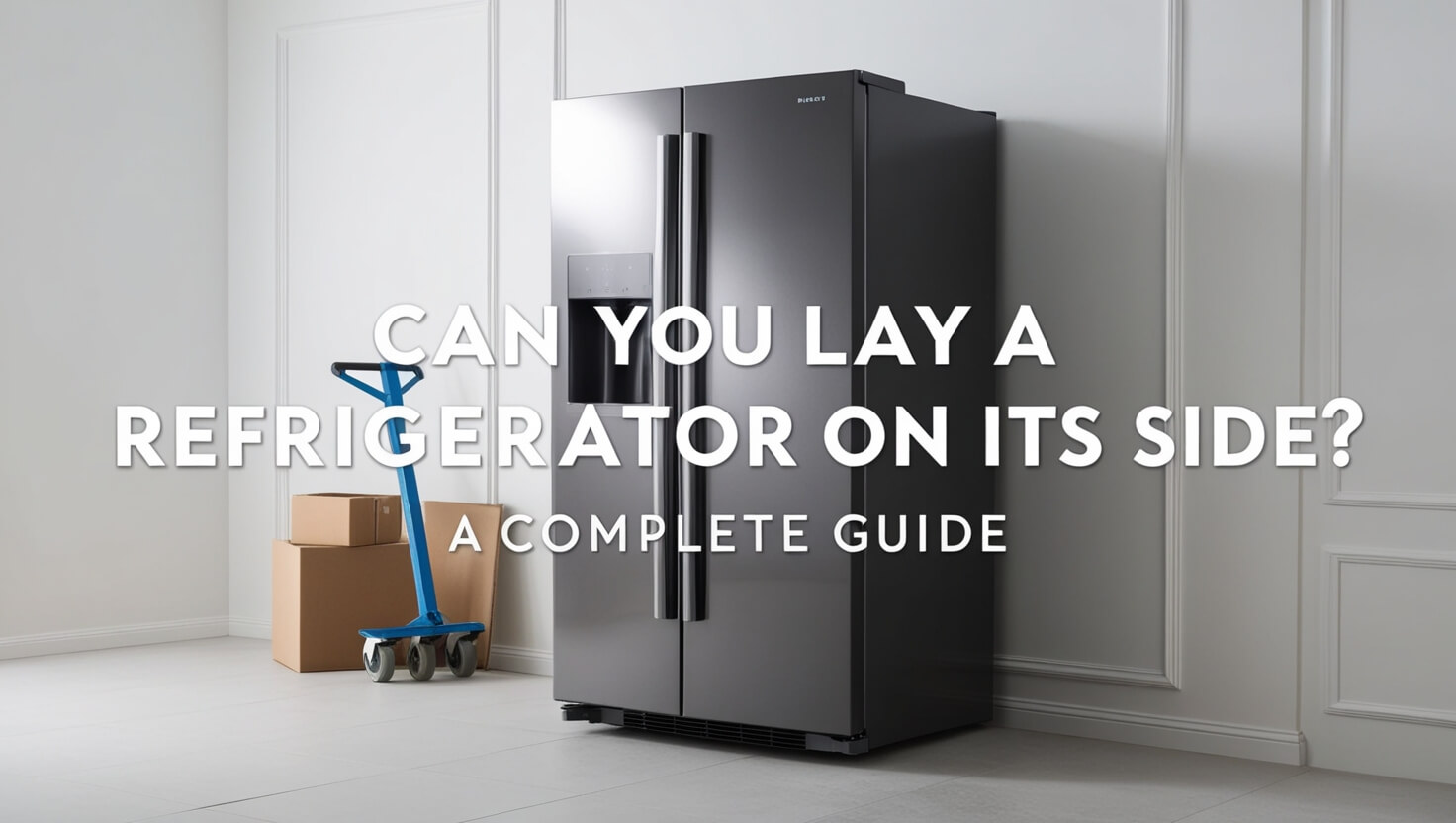Can You Lay a Refrigerator on Its Side?

Moving homes or remodeling your kitchen often raises a crucial question: can you lay a refrigerator on its side? The short answer is yes, but it’s not ideal. While it’s possible to transport a fridge on its side for short periods, doing so carries risks and requires careful handling. This guide will walk you through everything you need to know about laying a refrigerator on its side, including when it’s necessary, how to do it safely, and what precautions to take.
The Basics of Refrigerator Transportation
Before we dive into the specifics of laying a refrigerator on its side, it’s important to understand why this question matters and the basic components of a refrigerator that can be affected by its position.
Why the Question Matters
Refrigerators are complex appliances with delicate internal mechanisms. Their design assumes an upright position for optimal functioning. When you move a fridge, especially if you lay it down, you risk disrupting these mechanisms, potentially leading to damage or reduced performance.
Understanding Refrigerator Components
A typical refrigerator consists of several key components:
- Compressor: The heart of the cooling system
- Condenser coils: Release heat from the refrigerant
- Evaporator coils: Absorb heat from inside the fridge
- Refrigerant lines: Carry the coolant throughout the system
- Oil: Lubricates the compressor
When a refrigerator is upright, these components work together seamlessly. Laying it down can disrupt this balance, particularly affecting the oil and refrigerant distribution.
Can You Really Lay a Refrigerator on Its Side?
The Short Answer
Yes, you can lay a refrigerator on its side, but it’s not recommended unless absolutely necessary. Doing so can lead to potential issues with the cooling system and may void your warranty.
Risks and Considerations
Laying a refrigerator on its side poses several risks:
- Oil migration: The compressor oil can flow into the cooling lines
- Refrigerant displacement: The coolant may move to unintended areas
- Component stress: Internal parts may be stressed in unnatural positions
- Damage to doors and seals: The weight of the fridge can strain these parts
These risks increase with the duration the fridge spends on its side and the specific model of the refrigerator.
When Might You Need to Lay a Refrigerator Down?
Despite the risks, there are situations where laying a refrigerator on its side might be necessary.
Common Moving Scenarios
- Narrow doorways or staircases
- Low overhead clearance in moving vehicles
- Tight elevator spaces
Space Constraints in Vehicles
Some moving trucks or personal vehicles may not have enough vertical space to transport a refrigerator upright. In these cases, laying it down might be the only option to fit it in the vehicle.
Step-by-Step Guide: Laying a Refrigerator on Its Side
If you must lay your refrigerator on its side, follow these steps to minimize potential damage:
Preparation Before Moving
- Empty the refrigerator completely
- Remove all shelves and drawers
- Defrost the freezer if necessary
- Clean the interior to prevent odors
- Secure the doors shut with tape or moving straps
Choosing the Correct Side
Always lay the refrigerator on the side opposite the hinges. This helps prevent strain on the door mechanism. For most models, this means laying it on its right side when viewed from the front.
Securing the Refrigerator
- Use moving blankets to protect the exterior
- Place a piece of cardboard or a thin sheet of plywood under the fridge to distribute weight evenly
- Use straps to secure the refrigerator to prevent sliding during transport
Proper Lifting Techniques
- Use a dolly or hand truck to move the refrigerator to the vehicle
- Have at least two people to lift and position the fridge
- Bend at the knees and lift with your legs, not your back
- Communicate clearly with your moving partners
What Happens Inside When You Lay a Refrigerator Down?
Understanding the internal processes can help you appreciate the importance of careful handling.
The Role of Refrigerant and Oil
In an upright refrigerator, the compressor oil sits at the bottom of the compressor. When laid down, this oil can migrate into the refrigerant lines. Similarly, the refrigerant, which is normally distributed throughout the system, can pool in areas it shouldn’t be.
Potential Issues with Internal Components
- Compressor damage: If oil doesn’t return to the compressor, it may run dry and overheat
- Blocked refrigerant lines: Oil in the lines can impede refrigerant flow
- Evaporator issues: Refrigerant in the wrong places can cause inefficient cooling
How Long Can a Refrigerator Stay on Its Side?
The duration a refrigerator can safely remain on its side depends on several factors.
Time Limits and Best Practices
As a general rule:
- For brief transport (less than an hour): Wait at least 3 hours before plugging in
- For longer periods (several hours to a day): Wait 24 hours before use
- If on its side for more than a day: Wait 48 hours before operation
Factors Affecting Safe Duration
- Refrigerator age and model
- Specific side it’s laid on
- Temperature during transport
- Smoothness of the journey (bumpy rides increase risk)
Always consult your refrigerator’s manual for model-specific guidelines.
What to Do After Laying a Refrigerator on Its Side
Proper handling after transport is crucial to ensure your refrigerator works correctly.
Waiting Period Before Plugging In
The waiting period allows the oil to settle back into the compressor. Rushing this step can lead to serious damage.
- Stand the refrigerator upright
- Wait the recommended time based on how long it was on its side
- Listen for any unusual noises when you first plug it in
Proper Upright Positioning
- Ensure the refrigerator is level
- Leave space around it for proper air circulation
- Clean the coils before first use
Checking for Damage
Before fully restocking your fridge:
- Check for any external damage
- Listen for unusual sounds when the compressor runs
- Monitor temperatures for the first 24 hours of operation
Alternatives to Laying a Refrigerator on Its Side
Whenever possible, it’s best to keep a refrigerator upright during transport.
Upright Transportation Methods
- Use a tall moving truck with sufficient clearance
- Rent an appliance dolly with straps
- Consider disassembling doors if clearance is an issue
Professional Moving Services
Hiring professionals experienced in moving large appliances can be worth the cost:
- They have specialized equipment
- Professionals understand proper handling techniques
- Many offer insurance for peace of mind
Myths and Facts About Transporting Refrigerators
Let’s clear up some common misconceptions about moving refrigerators.
Common Misconceptions
- Myth: You can never lay a refrigerator down Fact: It’s possible, but not ideal and requires precautions
- Myth: Any side is fine for laying down a fridge Fact: The non-hinge side is best to minimize stress on the door
- Myth: You can use the fridge immediately after standing it up Fact: A waiting period is crucial to allow oil to settle
Expert Advice and Industry Standards
Most manufacturers and moving experts agree:
- Keep refrigerators upright whenever possible
- If laying down is necessary, minimize the time spent on its side
- Always follow the recommended waiting periods before use
Tips for Safely Moving a Refrigerator in Various Situations
Different moving scenarios require different approaches.
Short Distance Moves
For moves within the same building or to a nearby location:
- Use an appliance dolly
- Keep the refrigerator upright
- Secure doors with tape or straps
- Plan your route to avoid obstacles
Long-Distance Transportation
When moving far:
- Consider professional moving services
- If using a moving truck, secure the fridge tightly in an upright position
- Use climate-controlled transport if possible, especially in extreme weather
Dealing with Stairs and Tight Spaces
- Use a stair-climbing dolly if available
- Have at least three people to help navigate turns and steps
- Remove doors and handles if necessary for clearance
- Use furniture sliders on smooth surfaces
Potential Consequences of Improper Refrigerator Transportation
Understanding the risks can help you make informed decisions about moving your fridge.
Immediate Issues
- Compressor failure: Can occur if started too soon after being laid down
- Refrigerant leaks: Stressed lines may develop small leaks
- Door misalignment: The weight of the fridge can warp door frames
Long-Term Effects on Performance
- Reduced cooling efficiency
- Increased energy consumption
- Shortened lifespan of the appliance
- Intermittent or inconsistent cooling
When to Seek Professional Help
Sometimes, it’s best to leave it to the experts.
Assessing Your Moving Situation
Consider professional help if:
- You’re moving long distance
- You have a particularly large or valuable refrigerator
- There are challenging obstacles like multiple flights of stairs
- You’re unsure about proper handling techniques
Benefits of Hiring Experts
- Proper equipment and techniques
- Insurance coverage for potential damage
- Time and stress savings
- Reduced risk of personal injury
Frequently Asked Questions About Laying Refrigerators on Their Side
Let’s address some common queries:
Q1: Can I lay my fridge down for just a few minutes?
A: While brief periods are less risky, it’s still best to avoid it if possible. If you must, keep it to a minimum and follow the waiting period guidelines before use.
Q2: Does the type of refrigerator matter when laying it down?
A: Yes, different models have varying sensitivities. Side-by-side and French door refrigerators are generally more susceptible to damage when laid down compared to simpler top-freezer models.
Q3: What if I hear gurgling sounds after standing my fridge back up?
A: This is normal and usually indicates the refrigerant settling. If the noise persists for more than a day, consult a technician.
Q4: Can laying a fridge on its side void the warranty?
A: It can, depending on the manufacturer. Always check your warranty terms and consider professional moving services if warranty coverage is a concern.
Q5: Is it safer to lay a freezer on its side compared to a refrigerator?
A: The risks are similar for both appliances. The same precautions and waiting periods apply to freezers as they do to refrigerators.
Conclusion
While it’s possible to lay a refrigerator on its side for transport, it’s not the ideal method. If you must do so, take precautions to minimize potential damage:
- Choose the correct side (opposite the hinges)
- Secure the doors and internal components
- Keep the time on its side to a minimum
- Follow proper waiting periods before use
Remember, the safest option is always to keep your refrigerator upright during a move. If you’re unsure or dealing with a particularly valuable or large appliance, consider hiring professional movers. They have the expertise and equipment to transport your refrigerator safely, giving you peace of mind during your move.
By following these guidelines, you can significantly reduce the risk of damage to your refrigerator when moving. Whether you’re relocating across town or across the country, proper handling of your appliances will help ensure they continue to serve you well in your new home.



